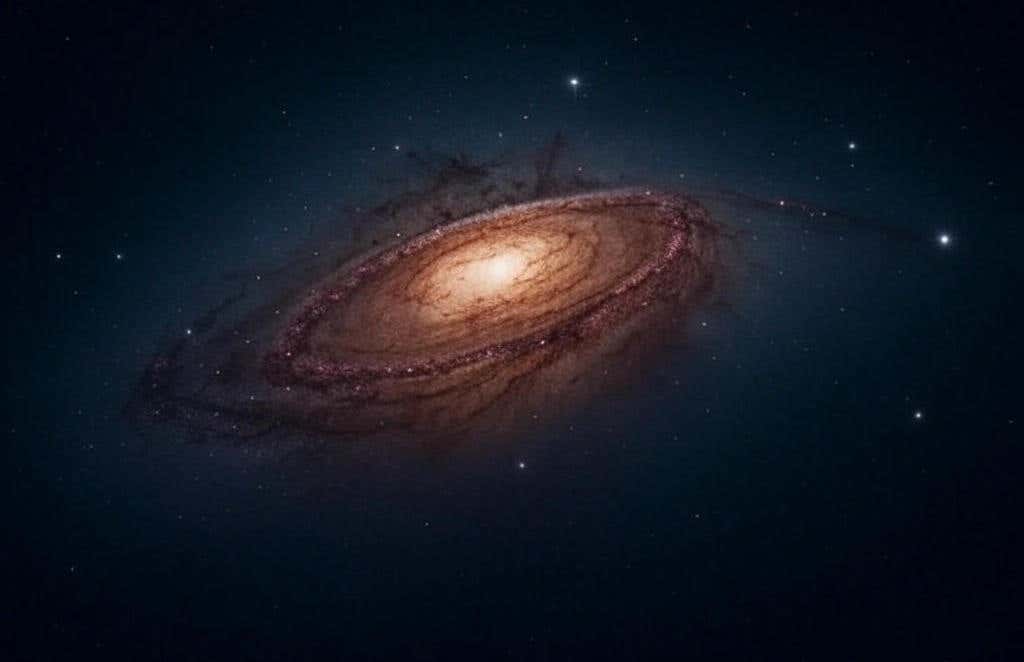Prematurely dead galaxy challenges what scientists knew about the early universe
A massive galaxy that went silent just 700 million years after the Big Bang is shaking up what we know about early cosmic history.

A distant galaxy stopped forming stars just 700 million years after the Big Bang, challenging cosmic formation models. (CREDIT: Grok 3)
A team of astronomers from the University of Geneva used the James Webb Space Telescope (JWST) to spot the most distant quiescent galaxy ever found. The discovery, made just 700 million years after the Big Bang, shows that galaxies may have grown large and stopped forming stars much earlier than anyone expected.
This galaxy, called RUBIES-UDS-QG-z7, is massive and dead — meaning it no longer creates new stars. But what makes it even more surprising is that it had already gone quiet at a time when galaxies in the Universe should have still been young and bursting with newborn stars.
A Galaxy That Stopped Growing Too Soon
In the early Universe, most galaxies formed stars at a fast pace. They pulled gas from their surroundings and used it to create new stars, growing quickly in size. This cycle continued until something caused them to stop. Astronomers call this process “quenching.”
Quenched galaxies, also known as quiescent or “red and dead” galaxies, no longer show signs of star formation. Instead of the bright blue glow from hot young stars, they appear red due to older, cooler stars. In today’s Universe, about half of all galaxies are quiescent. Many of these are massive and have an elliptical shape.
Scientists thought it took billions of years for such galaxies to form. That made the new discovery a shock.
The galaxy RUBIES-UDS-QG-z7 formed more than 10 billion solar masses of stars in less than 600 million years after the Big Bang. Then, it suddenly shut down star formation just 50 to 100 million years before astronomers observed it — a rapid and early death.
"The discovery of this galaxy...implies that massive quiescent galaxies in the first billion years of the Universe are more than 100 times more abundant than predicted by any model to date," said Andrea Weibel, a PhD student and lead author of the study. That means scientists may have to rethink how galaxies form and evolve.
Related Stories
A Record-Breaking Observation with James Webb
The team found this ancient galaxy using JWST’s NIRSpec instrument during the RUBIES program — a large European-led survey designed to explore the early Universe. The name RUBIES stands for "Red Unknowns: Bright Infrared Extragalactic Survey."
The data revealed a deep Balmer break in the galaxy's spectrum. This break is a sharp drop in light, which signals that most of the stars in the galaxy are old and not forming anymore. Scientists also noticed a Lyman break and signs of calcium and hydrogen absorption lines, which further confirmed that the stars had stopped forming.
The galaxy showed no emission lines, which would normally appear when young, hot stars energize the surrounding gas. Without them, scientists concluded that this galaxy had truly gone silent. Pascal Oesch, a co-author and astronomy professor, explained, “Finding the first examples of massive quiescent galaxies in the early Universe is critical as it sheds light on their possible formation mechanisms.”
Until now, astronomers had spotted quiescent galaxies as far back as 1.2 billion years after the Big Bang — a time known as redshift 5. RUBIES-UDS-QG-z7 breaks that record, appearing at redshift 7.29. That places it in an age of the Universe where astronomers thought star formation still ruled.
What Could Cause Such Early Quenching?
In the standard model of cosmic growth, galaxies form stars for hundreds of millions or even billions of years before slowing down. So what could make a galaxy stop so early?
Researchers think powerful feedback from massive stars and black holes may blow away the gas needed to make new stars. But even the best models have trouble matching what JWST now shows.
RUBIES-UDS-QG-z7 challenges the idea that galaxies needed time to build their mass and then shut down. It formed stars extremely fast, reached a mass of over 10 billion Suns, and then completely stopped forming stars — all before the Universe hit its first billionth birthday.
“The discovery of this galaxy...suggests that key factors in theoretical models...may need to be revisited,” said Weibel. In other words, existing theories may be missing important details about how galaxies live and die.
Small in Size, Heavy in Density
The galaxy isn't just interesting because of how early it formed. Its structure also offers clues about how massive galaxies we see today got their start.
RUBIES-UDS-QG-z7 has a very compact size, just 650 light-years across. Despite its small footprint, it packs a huge amount of mass into that space. This means it has a very high stellar mass density — similar to the dense centers of today’s massive elliptical galaxies.
That’s an important hint. Scientists believe these dense cores might survive for billions of years, even as galaxies grow larger through mergers and accretion. RUBIES-UDS-QG-z7 may be a fossil — the ancient seed of a modern galaxy core.
Anna de Graaff, second author of the paper and lead scientist of the RUBIES program, explained, “The discovery...provides the first strong evidence that the centers of some nearby massive ellipticals may have already been in place since the first few hundred million years of the Universe.” This finding links the distant past to the present, showing that even the oldest galaxies we see today might have formed their cores very early in cosmic history.
Why This Matters for the Big Picture
This discovery does more than break records. It reshapes the timeline of galaxy evolution. Astronomers now know that galaxies formed faster and quenched earlier than theory predicts. RUBIES-UDS-QG-z7 is only one example, but it suggests there could be many more like it.
The team behind the RUBIES program collected data from thousands of galaxies, many of which came from early JWST imaging. Scientists expect even more surprising discoveries as they continue to dig through this vast treasure trove of information.
For now, RUBIES-UDS-QG-z7 is a sign that the early Universe was more diverse and dynamic than we imagined. It shows how far technology has come — and how much more we still have to learn about the origins of galaxies, stars, and the Universe itself.
Research findings are available online in The Astrophysics Journal.
Note: The article above provided above by The Brighter Side of News.
Like these kind of feel good stories? Get The Brighter Side of News' newsletter.



